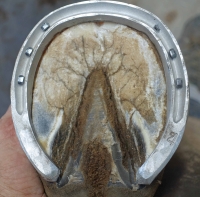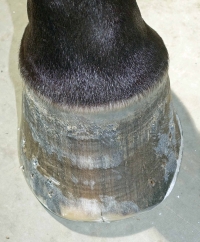Knee-knockers are a major headache to all horsemen at one time or another. Concern, frustration, and time lost can take them to the edge of their tolerance.

Photos by the author
Figure 1: A horse with rotational and angulated deviations in the knee joint.
The main reason for frustration is not knowing why the horse is hitting his knees. Horses hit their knees—meaning that while they are in motion, a horse will strike his knee with his opposite front foot--for different reasons, so different shoeing applications help various knee knockers.
The first step to getting a racehorse off his knees is to understand why it is happening. Much of the time it begins to occur due to faster training speeds or gait changes; however, when a horse that is racing begins to hit his knees, when previously clean-going, means that something has changed.
Classifying knee-knockers can help to decide what will improve them. The first type should be the chronic knee knocker. Fig. 1 shows a horse with rotational and angulated deviations in the knee joint. Horses with this conformation almost have to swing the lower leg inward and toward the other leg when the knee is folded during a stride.
One of the remedies for knee-knockers is to lower the lateral branch of the hoof that is striking the opposing knee. Doing this to the horse in Fig. 1 will eventually force the lower joints out of conformational alignment with the knee joint, causing secondary lameness problems and possibly even more knee-knocking. While working on a chronic knee-knocker last winter, I found that lowering the outside of the hoof made the lower leg joints look horribly out of place with the rest of the leg.
Trimming that hoof completely the opposite of conventional thought for knee-knockers, I lowered the inside branch of the hoof wall; this made the knee, ankle, and fetlock joints appear to be in better alignment with each other. That and a square-toe shoe (Fig. 2) had the horse only brushing his knees.
Sometimes, that is the best you can do with the chronic knee-knocker.

Figure 2: Adding a square-toe shoe can help a horse brush his knees instead of striking them while in motion.
Another type of knee-knocker is the horse that is sore-footed. Pounding the track takes its toll. If a previously clean-gaited horse has begun to hit his knees, check those front feet before anything else. It is sometimes necessary to check them directly after a race or training session to know what is going on.
One thing to be mindful of are the circumstances likely to create sore feet. If a big horse has a tightly fitted shoe, a toe length of 3-1/2 inches or less, and no sole depth in the front feet, it is safe to assume those feet are stinging and sore when the race is going on. If the driver says a horse is hitting its knees late in the race it is likely to be from sore feet.
Rim pads alone might help a horse in this situation. Determine why the feet are sore; for horses with short toes and flat-soled feet, use pads. Heel bruising needs frog pressure to better activate the digital cushion (as mentioned in the article in the September 2016 issue) and to help dissipate the forces of hitting the racetrack. Sore coffin joints may need veterinary intervention, but could certainly benefit from an easier break-over and less toe grab. Sound front feet always equal less interference.
Restricted gait is another class of knee-knocker. This could happen for many reasons—with sore feet among them. Small tracks and tight hobbles to accommodate those tracks could be a factor. Tying up and other muscle soreness can lead to a restricted gait. Slipping too much can also restrict the gait. If slipping excessively, a horse will naturally shorten up the stride to keep the feet closer to its center of gravity--much the same way we would when walking on ice. Sore feet and slipping are addressed by shoeing. When other reasons exist, it is good to know when not to change the shoeing, thereby complicating matters.
The old way of addressing knee-knockers was to lower the outside branch of the offending hoof and add traction to the lateral (outside) branch of the shoe. Tipping the hoof (lowering the outside) disengages that side of the shoe. Adding traction to the branch of the shoe that is disengaged by trimming makes little sense to me.

Figure 3: This shoe was nailed on wider than the hoof to provide lateral support.
One thing that is helpful in many cases is lateral support. Many knee-knockers lack enough width on the lateral, or outside half, of the hoof. When this is evident, I will fit the shoe wider than the hoof on that side to regain symmetry and equalize medial/lateral support (Fig. 3).
Basic concepts that always apply are square-toe shoes to reduce any pivoting effect at the moment of break-over. Keep the shoes lightweight, because added weight increases animation and any deviant motion. Keep those front feet sound and check them often. Make sure that horse is moving freely. Make certain the front hooves are well-balanced and avoid hoof distortion (flares) that make that hoof bigger on the medial side, which creates a bigger “club” to hit the knee.
The frustration involved when trying to stop this interference gets to us all at one time or another. A Hall of Fame trainer once told me the best way to stop a bad knee-knocker is to put the horse in the next sale. With any problem, the only way to a cure is to understand the cause. Classifying knee-knockers can help to zero in on causes thus narrowing possible solutions.
As an interference headache, hitting the knees is in a class by itself. In terms of ways to help them, class never ends for anyone in the “school of hard knocks.”
Veteran Standardbred farrier Steve Stanley of Lexington, Ky., authors a monthly column for Hoof Beats, the official harness racing publication of the U.S. Trotting Association. The American Farriers Journal Editorial Advisory Board member offers plenty of practical advice that will be of special interest regardless of the type of horses that you work with. Click here to read more from Steve Stanley's Hoof Beats series.








Post a comment
Report Abusive Comment